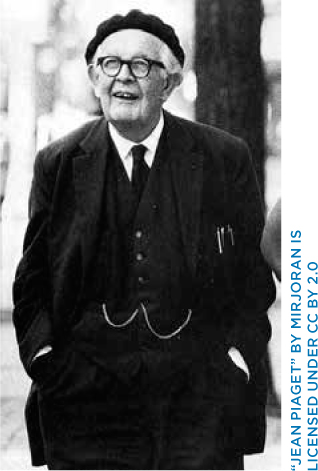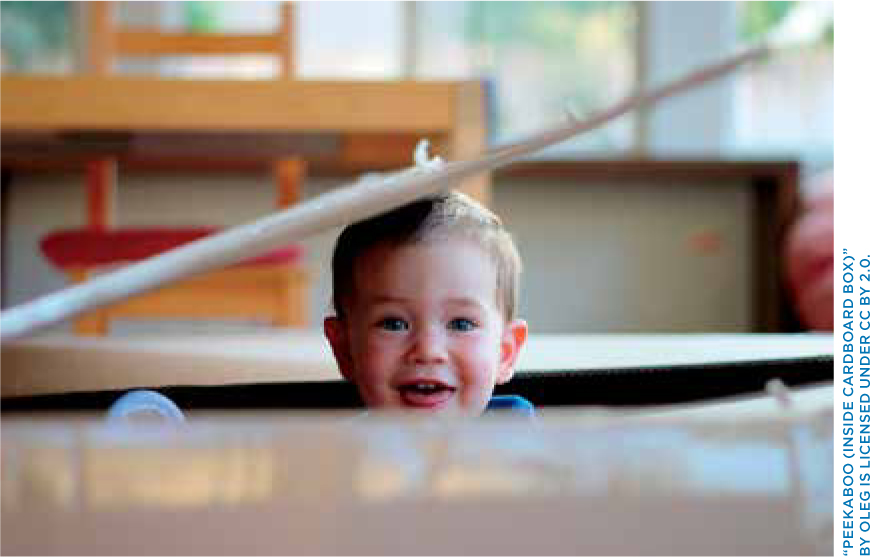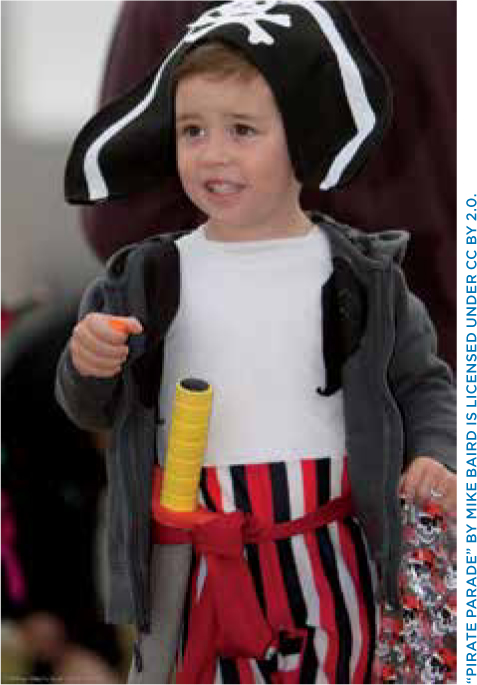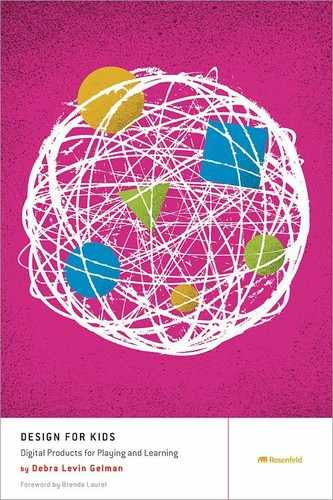
CHAPTER 3
Development and Cognition
Theory of Cognitive Development
The Sensorimotor Stage: From Birth to Age 2
The Preoperational Stage: Ages 2–6
The Concrete Operational Stage: Ages 7–11
Noah, Age 3
Knowing reality means constructing systems of transformations
that correspond, more or less adequately, to reality.
—Jean Piaget
It’s important for us as designers to have a basic understanding of our users’ cognitive abilities. When designing for adults who fall on the “normal” spectrum, we can be pretty confident that they’re able to use deductive reasoning, think abstractly, understand common symbols and icons, and anticipate the outcome of their actions, and we can design accordingly. With kids, this is all up for grabs, especially given how rapidly kids develop. Let’s take a quick look into the developmental and cognitive skills of kids in different age groups so we can have a common frame of reference when we start talking about design and research.
The World According to Piaget
Jean Piaget was a Swiss psychologist born in the late 19th century (see Figure 3.1). While completing his post-doctoral work in Paris, Piaget took a job at an elementary school where he analyzed the results of intelligence tests. He noticed that younger kids repeatedly struggled with certain types of questions that older kids and adults had no trouble answering. Based on these observations, he decided that younger children weren’t necessarily less intelligent than older kids or adults; they just thought about things differently. Piaget focused his research on these cognitive differences and ultimately developed a theory of cognitive “stages” of development, based on age.

Jean Piaget, an innovator in education.
According to Piaget, when kids are born, they are in the sensorimotor stage. “Sensorimotor,” which means to function with physical senses and movement, refers to the stage when kids “begin to build up direct knowledge of the world around [them], by relating physical actions to perceived results of those actions.”1 They progress through several other stages until they arrive at the formal operational stage, where they can think logically, use abstract reasoning, and see things from perspectives other than their own. Piaget’s Theory of Cognitive Development,2 based on extensive research with children, details the differences in these stages.
NOTE EINSTEIN ON PIAGET
Albert Einstein called Piaget’s theory “So simple only a genius could have thought of it.”
Piaget maintained that cognitive development progresses from understanding based on physical actions to understanding based on mental operations. He based his theory on four main learning concepts:
• Schemata
• Assimilation
• Accommodation
• Equilibrium
Schemata
Schemata refer to the behaviors that help very young children understand and interpret the world around them. These schemata are actions that a child takes upon an object, to determine its use and purpose. The most basic example of how a schema is formed is the sucking reflex. If an infant picks up an unfamiliar object, he’ll immediately put it in his mouth to see how it responds when he sucks on it. This is how he tries to figure out what that object is—if it doesn’t fit into his schema for breast or bottle, it’s not important to him. As he gains experience, his schemata will progress in development from sucking, to shaking, to dropping, and so forth. And his understanding and classification of the objects that make up his world will expand as well.
In a virtual environment, we have the opportunity to further develop a child’s digital schemata by creating lots of cool elements for him to interact with—items that promote clicking, shaking, tapping, and dragging. These behaviors will help the child learn the gestures and interactions he’ll use in the future.
Assimilation
While schemata are how kids classify objects by physically interacting with them, assimilation refers to how children classify objects in their minds, when they see them. So a young child, after seeing and using many bottles over the course of her short lifetime, will be able to look at a bottle (or a picture of a bottle) and identify it as a bottle without needing to suck on it to make that determination.
In his groundbreaking book, The Design of Everyday Things, Don Norman uses the term “affordance” to refer to the properties of an object that communicate its intended use.3 This concept requires a certain level of assimilation—as well as accommodation—in order to hold true. For example, when you see a doorknob, you know you’re supposed to turn it to open the door, because you’ve assimilated the properties of a doorknob from the schemata you developed as a child, when you actually held and turned a doorknob for the first time.
A child will know how to use a bottle (and then a sippy cup, and then a straw) based on the knowledge he assimilated from his schemata. Assimilation is closely related to the concept of accommodation, which is the exciting point when kids figure out deductive logic.
Accommodation
Accommodation is what happens when children modify their existing beliefs about an object based on what they have assimilated.
My favorite example of this is a story I heard from my friend Erin, about the first time her little brother went to the Smithsonian’s American Museum of Natural History in Washington, DC. They walked into the lobby and saw the huge skeleton of a wooly mammoth. Erin’s brother pointed at the skeleton and said, “biiiiig doggie!” He assimilated the visual information in front of him (animal with four legs) into his own interactions with an animal with four legs, which was a dog, and concluded he must be looking at a dog.
When his parents told him that no, in fact, not all animals with four legs are dogs, and that in fact, this was a prehistoric being called a wooly mammoth, he was able to accommodate this information into a new classification in his mind—a giant, prehistoric animal with four legs and two massive tusks, which was much bigger than the elephants at the zoo.
Equilibrium
Equilibrium refers to the balance that people must strike between assimilation and accommodation. As children get older, they have to achieve a balance between when they apply previous knowledge and when they have to account for new knowledge. As they mature, kids get better at accommodating a greater number of variables per object, so they are not classifying things based on only one or two characteristics. When they run out of characteristics to assimilate, they must accommodate objects based on new ones.
In the previous example, when he got more cognitively mature, Erin’s brother was able to look at all different kinds of animals with four legs, as well as other characteristics, and determine whether they were something he’d already assimilated, or if they represented something new that he’d have to accommodate for.
Kids struggle with equilibrium as they go through the maturation process. My 5-year-old is convinced that every black car she sees in the parking lot belongs to my husband. She’s just starting to look for the Hyundai symbol on the back as she moves toward equilibrium.
NOTE ADULTS AND EQUILIBRIUM
Adults struggle with equilibrium, too! Have you ever been somewhere unfamiliar and, based on a particular building or landmark, think you’ve been there before? That’s your brain trying to decide whether it should assimilate the visual information into an existing category or accommodate it into a new one.
Theory of Cognitive Development
The previous four concepts—schemata, assimilation, accommodation, and equilibrium—make up Piaget’s Theory of Cognitive Development. Next, let’s take a look at the four stages within this theory:
• Sensorimotor Stage
• Preoperational Stage
• Concrete Operational Stage
• Formal Operational Stage
It’s important to note that, while Piaget focused on cognitive development, when designing for kids, you need to look at emotional, physical, and technological development as well. To account for this, in Chapters 4–8, I’ve broken these cognitive stages into two-year increments to more effectively address the unique needs of children, who evolve quickly across multiple areas. Remember that designing for a 3-year-old is very different than designing for a 6-year-old, even though both these kids fall into the preoperational stage.
The Sensorimotor Stage: From Birth to Age 2
The sensorimotor stage is fascinating because it is the time when kids start figuring out the world and their place in it through their own actions and behaviors. It’s important to note here that the American Academy of Pediatrics recommends no screen time (TV, computer, tablet, phone, and so on) until kids reach the age of two, and I agree with this, since these little ones are still discovering the intrinsic properties of the basic physical objects that make up their world. If a plain cardboard box is a super-exciting plaything to babies, then a screen with brightly colored pictures jumping around on it might be a little too much for them to handle. Admittedly, keeping kids away from technology until they’re two is a tough proposition. If you’re planning to design for the under-two set, here are some key things to remember about this stage.
Separate Selves
When babies are born, they believe that everything in their environment is connected to them. During the sensorimotor stage, they begin to realize that they are not, in fact, so tied to the objects around them, and that they can move and manipulate these objects separately. Babies start experiencing separation anxiety around 8 or 9 months of age when they realize a parent is a separate entity and not simply a ubiquitous extension of themselves.
Object Permanence
The object permanence phase is an important phenomenon of the sensorimotor stage because it’s when babies learn that objects and people continue to exist even when they’re hidden from view. This is a delightful discovery for babies, and can result in lengthy games of “peek-a-boo” with parents, toys, pets, and, really, anything that can be easily covered with a blanket (see Figure 3.2). When tots learn about object permanence, their separation anxiety tends to lessen a little bit, as they realize their parents still exist even after they leave and will come back for them soon.

Object permanence means that babies realize objects still exist even when they’re hidden from view.
Early Representational Thought
Toward the end of the sensorimotor stage, toddlers are able to start using the schemata they’ve developed to interpret items in their environment instead of needing to touch and act on everything.
This is important because they are starting to reason and to learn by seeing instead of only by doing. This phenomenon happens between 18 and 24 months of age and propels kids into the next stage, the preoperational stage.
The Preoperational Stage: Ages 2–6
“Preoperational” is a term that Piaget developed to refer to children who don’t yet understand “concrete logic” and can only see things from their own point of view. Kids enter the preoperational stage at around age two. This is a very exciting developmental stage, especially for parents, because this is when kids start using language as a communication tool. Even if toddlers aren’t speaking at this point, they’re probably understanding almost everything they hear, which indicates their ability to associate words with physical objects.
You’ll find that this is also a great stage to design for, because it’s the stage when kids are able to pretend. A feather duster becomes a magic wand, a towel becomes a cape, and a plate becomes a steering wheel. Toddlers also start acting (playing) out different roles in this stage, like “mommy,” “doctor,” “pirate,” and “fireman” (see Figure 3.3).

Kids start playing pretend in the preoperational stage.
As designers, we especially need to observe kids in this stage, because despite the fact that they’re developing language skills, they’re still not able to clearly articulate their thoughts and behaviors (an issue that continues through adulthood).
Important aspects of this stage include egocentrism and conservation.
Egocentrism
Despite their ability to pretend, children this age have a hard time seeing things from other people’s perspectives, and they tend to be very egocentric in their attitude toward life. Piaget conducted an experiment, called “The Three Mountain Test,” where he sat kids at a table in front of three 3D mountains and put a doll on the other side of the table. He then asked the children to draw the mountains from the doll’s point of view. All the kids in the experiment drew the scene from their own visual perspective, since they couldn’t figure out that the view from the other side of the table might be different (see Figure 3.4). In Chapter 4, we’ll talk about how to handle this phenomenon when designing for these kids, but suffice it to say, you’ll want to present everything from the child’s perspective. This is harder than it sounds. Stay tuned.

Piaget’s famous “Three Mountain Test” experiment shows that kids in the preoperational stage can only see things from their own perspective.
Conservation
Since these children aren’t yet able to think abstractly, they’re only able to understand the visual information in front of them. In Piaget’s famous conservation experiment, he poured the same amount of water into two identical containers, in front of a group of kids. Then he took one of the containers and poured it into a taller, thinner container. Even though the kids watched him pour the water into the taller container, they still said the taller container now had more liquid in it, simply because it looked fuller (see Figure 3.5). This perception changes relatively quickly when kids enter the next phase, the concrete operational stage, but it presents challenges when designing for this age group, because you’ll have to be very conscious of how you present every piece of visual information.

In Piaget’s conservation experiments, kids were unable to tell that both cylinders held the same amount of water.
The Concrete Operational Stage: Ages 7–11
In the concrete operational stage, children are able to think logically about concrete ideas or events but have difficulty understanding abstract concepts or hypotheses. This means that, while they are starting to understand symbols and representations, it’s hard for them to extrapolate meaning using abstract thought. It’s a little easier to design for these kids, since you don’t have to rely solely on visual examples, but it presents its own set of challenges. For example, you won’t be able to use some of the symbols and icons you’d use with an adult audience, so you’ll have to make sure your interface communicates its use without these (see Chapter 5).
Important aspects of this phase include inductive logic and reversibility.
Inductive Logic
Piaget found in this stage that children were able to use inductive logic, meaning that they were able to apply reasoning from a specific situation to a larger, more general situation. For example, if you push your friend and your friend gets angry, you learn that people get upset when you push them. However, children this age haven’t yet learned to use deductive logic, and understand that, if their friends get upset when they push them, they shouldn’t push them.
Reversibility
Despite the lack of deductive reasoning in this age bracket, these kids are starting to be able to reverse their mental categorization. For example, a child may be able to realize that his fish is a betta, and therefore a betta is a fish, and a fish is a type of animal.
The Formal Operations Stage: Ages 12–Adult
We all know how to design for people in the formal operations stage. It’s the people you design for every day—your adult users whom you know so well (or try to, at least). The important hallmarks of this stage are the development of logical thought, deductive reasoning, and complex problem solving.
You’ll want to consider the following areas when designing for this phase: logic, abstract thought, and problem solving.
Logic
According to Piaget, logic refers to the ability to use general concepts to solve a specific problem. Remember those algebra classes in middle school? The reason you had to take them, even though you were way more interested in art and drama, was to hone your deductive reasoning skills. So while you may never have to solve for x as an adult, you use the logic you developed almost every day.
Abstract Thought
Surviving as an adult requires the ability to hypothesize about the potential outcomes of one’s actions and decisions. Children develop this cognitive skill at around age 12. This means that, instead of relying on past experiences as the basis of their decisions, kids are able to think hypothetically about their options. These skills are essential for future planning.
Problem Solving
Before they reach the formal operations stage, children use trial-and-error to solve problems. In the formal operations stage, kids are able to draw on logic and deduction to develop solutions to complex problems. When you design for adults, you tend to (correctly) assume that they have this ability, unless you design for special populations.
Chapter Checklist
Here’s a checklist to test your knowledge about what was discussed in this chapter.
In this book, we’re going to draw on the principles described here to explain how to design for children of different ages. In the next chapter, we’ll take a look at kids in the early preoperational stage, from 2–4.
